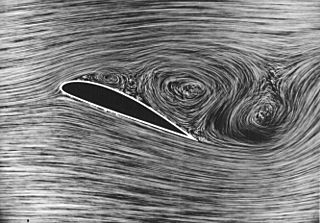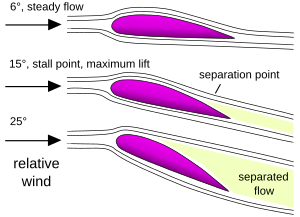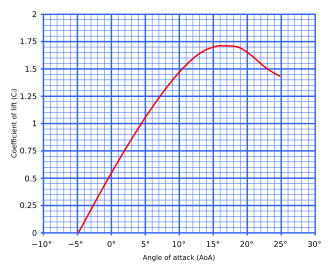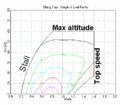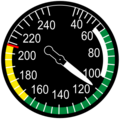Stall (fluid dynamics) facts for kids
In simple terms, a stall happens when an aircraft wing stops producing enough lift to keep the plane in the air. This usually occurs when the wing's angle of attack (the angle between the wing and the oncoming air) becomes too steep. When the angle gets too big, the air flowing over the wing separates instead of flowing smoothly, causing the lift to drop suddenly.
It's important to know that a stall doesn't mean the engines have stopped or the plane has stopped moving. Even a glider can stall. Pilots are trained to recognize and recover from stalls to keep flights safe. This article will mostly talk about stalls in airplanes, especially those with fixed wings.
Contents
What Is an Aircraft Stall?
A stall in aerodynamics happens when an aircraft's wing increases its angle of attack beyond a certain point. This point is called the critical angle of attack. If the pilot tries to increase the angle of attack past this critical point, the wing stops making enough lift, and the aircraft starts to drop. As it drops, the angle of attack can get even bigger, making the problem worse.
The critical angle of attack changes depending on the wing's shape, size, and other factors. But for most planes flying slower than the speed of sound, it's usually between 8 and 20 degrees. This is the angle where the wing creates the most lift possible.
Stalling happens because the air flowing over the wing separates from its surface. Imagine air trying to flow uphill against pressure. If the slope is too steep (high angle of attack), the air can't stick to the surface anymore. This separation usually starts near the back edge of the wing. As the angle of attack gets steeper, this separated area grows, moving forward over the wing. This makes the wing less effective at creating lift. When the air separates, it often causes the plane to shake, which pilots call "buffeting."
Older planes and early jetliners had good stall behavior. They would shake a bit before stalling, and if the pilot didn't react, the nose would naturally drop, making recovery easier. But newer wing designs and planes with engines at the back or high tails sometimes had worse stall behavior. Because of this, devices like "stick shakers" (which shake the controls to warn the pilot) and "stick pushers" (which automatically push the nose down) were developed to make planes safer.
If a plane's wings are stalled and it also starts to spin around its center, it can enter a spin. This happens when one wing stalls more than the other, causing the plane to rotate as it falls.
How Lift Changes with Angle of Attack
The graph shows how much lift a wing produces at different angles of attack. You can see that the most lift is made right when the critical angle of attack is reached. In this example, it's 17.5 degrees, but this number changes for different wing shapes. For thicker wings, the critical angle is usually higher than for thin wings.
This kind of information is found by testing small models of wings in a wind tunnel. It's important that these tests are done carefully so the results match what happens in real flight. For example, how air separates from the wing at high angles of attack can look different on small models than on real planes.
Normally, a pilot can't keep a plane flying steadily above its critical angle of attack. This is because once the critical angle is passed, the wing loses lift, and the plane's nose will drop. This nose drop, even without the pilot touching the controls, tells the pilot the plane has stalled.
Even though stalls depend on the angle of attack, most pilot manuals talk about "stall speed." This is because planes have airspeed indicators, but fewer have angle of attack indicators. A plane's stall speed is given by the manufacturer for different weights and flap settings.
As a plane slows down, the pilot has to increase the angle of attack to keep enough lift. Eventually, the critical angle is reached. The speed at which this happens is the plane's stall speed. Using flaps or slats (parts of the wing that extend) helps reduce the stall speed, allowing planes to take off and land at slower, safer speeds.
Stalls in Fixed-Wing Aircraft
A fixed-wing aircraft can stall in any position or at any speed. However, pilots usually practice stalls by slowing down to the stall speed at a safe height. On an airspeed indicator, the stall speed is often marked with color codes. As the plane flies at this speed, the pilot must increase the angle of attack to avoid losing height. The pilot will notice the controls feel less responsive and the plane might shake. This shaking is caused by the turbulent air from the stalled wing hitting the tail.
In most small planes, when a stall happens, the plane will start to drop, and its nose will pitch down. To recover, the pilot needs to lower the nose to reduce the angle of attack and gain speed. This helps the air flow smoothly over the wing again. Once the recovery is complete, the plane can fly normally. This maneuver is usually safe and only causes a small loss of height (about 20 to 30 meters or 65 to 100 feet). Pilots learn and practice stalls to recognize, avoid, and recover from them. It's a required skill for pilots to get their license. The only real danger of a stall is not having enough height to recover safely.
A special kind of stall where the plane also spins around is called a spin. This can happen if a plane stalls and there's also a sideways force, like from the rudder or strong wind. This makes one wing stall before the other, and the plane falls rapidly while spinning. Some planes are very hard to recover from a spin without the right pilot actions. A new safety feature for some planes is a ballistic parachute system that can help recover from a spin.
Stalls often happen during takeoff or landing because the plane is flying at low speeds. They can also happen if the wings are covered in ice or frost, which makes the surface rougher and increases the stall speed.
It's important to remember that stalls don't just happen at slow speeds. They can happen at any speed if the wings go beyond their critical angle of attack. For example, if a pilot pulls up sharply from a dive or makes a very steep turn, the wings need to create a lot more lift. If the pilot pulls back too hard on the controls, the critical angle can be reached even at high speeds. These "high-speed stalls" feel similar to normal stalls and can also lead to a spin if there's any sideways motion.
Stall Warning and Safety Devices
Planes can have different devices to help prevent or make stalls less dangerous, or to make recovery easier.
- Washout is a special twist in the wing design. The wing tip is slightly twisted downwards. This makes the inner part of the wing stall before the tip. This way, the stall is gentle, and the pilot can still control the plane's roll using the ailerons (which are usually on the wing tips).
- A stall strip is a small, sharp edge added to the front of the wing. It makes the stall start in a specific spot, usually near the wing root, to ensure a gentle stall.
- Vortex generators are tiny metal or plastic strips on top of the wing. They create small swirling air currents (vortices) that help the air stick to the wing for longer, delaying the stall.
- A stick pusher is a mechanical device that automatically pushes the pilot's control stick forward as the plane gets close to a stall. This lowers the nose and reduces the angle of attack, preventing the stall.
- A stick shaker is a mechanical device that shakes the pilot's control stick to warn them that a stall is about to happen.
- A stall warning horn is a simple device that makes a loud sound when the plane is getting close to its stall speed. Most planes have some form of this warning.
- An angle-of-attack indicator shows the pilot exactly how close the plane is to stalling. It's like a speedometer for lift. It reacts instantly to changes in speed, angle of attack, and wind, and it automatically adjusts for the plane's weight, height, and temperature.
- An angle of attack limiter is a computer system in some modern planes that stops the pilot from increasing the angle of attack beyond the stall point.
Sometimes, if the sensors for stall warnings or angle of attack get blocked or damaged, the warning systems might not work correctly.
In planes with a small front wing called a canard instead of a tail, the canard is designed to stall first. When the canard stalls, the nose drops, which prevents the main wing from reaching its critical angle of attack and stalling. This can make the plane safer. However, if the main wing does stall, recovery can be difficult.
Most military fighter jets have an angle of attack indicator so the pilot always knows how close they are to stalling. Modern airliners also measure angle of attack, but this information might not be shown directly to the pilot. Instead, it feeds into the stall warning system or the flight computer.
Flying Beyond the Stall
When a wing stalls, the ailerons (controls for rolling) become less effective, making the plane harder to control and increasing the risk of a spin. For very powerful aircraft, flying beyond the stall angle (where the wing makes the most lift) means the engines have to provide the lift instead of the wings. Also, other controls are needed because the ailerons don't work well.
Some military fighter jets, like the F-22 Raptor, can fly at very high angles of attack, even beyond a normal stall. This gives them a special advantage in air combat. Pilots sometimes perform amazing maneuvers at airshows, like the "Pugachev's cobra," where the plane briefly points its nose straight up (90-120 degrees) but keeps flying. The highest angle of attack ever shown in sustained flight was 70 degrees by the X-31 experimental jet.
Spoilers
Spoilers are devices on a wing that are intentionally used to reduce lift and increase drag. They are like flaps, but they work by disrupting the smooth airflow over the wing. Pilots use spoilers to make the plane descend faster without gaining too much speed. They are also used on one wing to help with rolling the plane.
On landing, spoilers are deployed after the wheels touch down. This helps push the plane down onto the runway, making the brakes work better.
Unlike powered planes that can control their descent by changing engine power, gliders need to increase drag to descend faster. Spoilers are very important for gliders to control their approach to landing.
History of Stalls
The German aviator Otto Lilienthal died in 1896 because of a stall. Wilbur Wright first experienced stalls in 1901 while flying his second glider. Because of these experiences, the Wright Brothers designed their first successful plane with a "canard" (a small wing at the front). They believed this design would make it easier and safer to recover from stalls, and it supposedly saved their lives more than once. However, canard designs can sometimes make stalls harder to recover from if not designed carefully.
The aircraft engineer Juan de la Cierva worked on his "Autogiro" (a type of aircraft with a spinning wing) because he wanted to create a plane that couldn't stall, making it safer than regular airplanes. His work helped solve many problems that later made the helicopter possible.
Images for kids
-
A Schweizer SGS 1-36 being used for deep-stall research by NASA over the Mojave Desert in 1983.
 In Spanish: Entrada en pérdida para niños
In Spanish: Entrada en pérdida para niños
- Articles
- Aviation safety
- Lift coefficient
- Spin (flight)
- Spoiler (aeronautics)
- Wing twist
- Notable accidents
- 1963 BAC One-Eleven test crash
- British European Airways Flight 548
- Air France Flight 447
- Colgan Air Flight 3407
- West Caribbean Airways Flight 708


